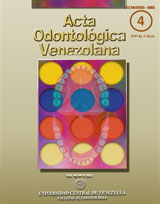INFLUENCIA DEL TIEMPO DE ALMACENAMIENTO EN LA RESISTENCIA DE UNIÓN A LA DENTINA DESPROTEINIZADA, UTILIZANDO TRES DIFERENTES ADHESIVOS DENTALES
Palabras clave:
Dentina, Hipoclorito de sodio, Resistencia a la tracción, Adhesivos dentales, Dentin Bond, Bond Strength and DentinResumen
Este estudio "in vitro" tuvo como objetivo evaluar a lo largo del tiempo (24 horas y 6 meses), el tratamiento del sustrato dentinario (desmineralización, desproteinización y antioxidante) y su influencia en la resistencia de la unión a la dentina, con tres adhesivos dentales. Noventa terceros molares humanos sanos recién extraídos se utilizaron: 72 para el ensayo de microtracción y 18 para análisis de interfaz en Microscopio electrónico de barrido (MEB). Estos fueron divididos aleatoriamente en tres grupos: AdperTM Scotchbond Multi-Uso (n=24); AdperTM Single Bond 2 (n=24); y XP Bond (n=24). Cada grupo fue dividido en 6 subgrupos (n = 4) de acuerdo con el tratamiento de la superficie dentinaria y el tiempo de evaluación. Sobre la zona de unión de todos los cuerpos de prueba se hizo un cilindro de 5 mm con resina compuesta FiltekTM Z250 (3M ESPE). Para el ensayo de microtracción se obtuvieron palillos (0,8 mm2). El análisis estadístico mostró que, a excepción del adhesivo XP Bond (65,07 ± 23,05), cuando se utilizó NaOCl, las otras medias fueron mayores en el tiempo de 6 meses que en 24 horas. El análisis del MEB mostró un patrón morfológico con capa híbrida uniforme y tags regulares. Considerando los resultados, se concluyó que la técnica con NaOCl dependió del sistema adhesivo y el tiempo, que la neutralización con el ascorbato de sodio revertió los valores obtenidos con NaOCl para ciertos grupos.
ABSTRACT
This in vitro study investigated the influence of time (24h and 6 months) the treatment of the dentin substrate (demineralization, deproteinization, and antioxidant), and its influence on the bond strength using three dental adhesives. Ninety healthy human third molars freshly extracted were used for the microtensile test (n=72) and SEM analysis (n=18) randomly divided into three groups: AdperTM Scotchbond Multipurpose (n = 24); AdperTM Single Bond 2 (n = 24) and XP Bond (n = 24). Each group was further divided into 6 subgroups (n = 4) according to the treatment and evaluation time. A cylinder of 5mm was produced on the area of union using the composite resin Z250 (3M ESPE) and sticks of 0.8mm2 were obtained for the microtensile test. The statistical analysis showed that when NaOCl was used the average bond strength at 6 months was higher for most groups, except for XP Bond (60.48 ± 21.14 MPa). SEM analysis showed an uniform hybrid layer morphology and regular tags. Considering the results the effects of the NaOCl treatment on the bond strength was dependent on the adhesive system and time, and neutralization with sodium ascorbate reversed the values obtained with NaOCl for certain groups.


